The modern market offers a wide choice of various floor coverings. They look great in chic mansions and in typical standard apartments. Laminated flooring and linoleum were well-deservedly popular. Cost good linoleum, the laminate is almost the same. In appearance, laminate is preferred. But not always such coverage can please longevity. There is a question: a laminate or linoleum, what is better? Unequivocally can not be answered.
Not always the priority in choosing a coating is precisely the quality. Often the owners pay special attention to the design of the apartment, the original design. But still, let's compare linoleum and laminate flooring, we'll try to determine in which case we can use this or that coating.
We will not consider natural linoleum. Of course, it's ridiculous to compare it with an artificial laminate. These are really different weight classes. Therefore, the comparison of synthetic linoleum and artificial laminate will be correct.
There are three main types of PVC linoleum: household, semi-commercial and commercial.
The most dense and durable commercial linoleum is considered. It is desirable to use it in rooms with high traffic and traffic. It is recommended to apply for high-quality flooring in offices, medical, educational institutions, in commercial premises.
Household linoleum is not so strong. But it is great for any living quarters. It will not be difficult to choose the color scheme, which is ideal for your apartment.
We should pay tribute to the semi-commercial linoleum. Undoubtedly, it will last longer than domestic, as it is more durable. At the same time, a huge assortment of colors will not disappoint the most demanding client. Semi-commercial linoleum can decorate living quarters and cover the floors inside public buildings.
Advantages of linoleum:
- Low cost.
- A rich choice of colors. You can easily pick up a floor covering, which is ideal for any design solution.
- Simplicity of installation: it is not necessary to be a professional to independently lay linoleum.
- Linoleum has a comfortable temperature. It is rarely cold, due to low thermal conductivity.
- Synthetic linoleum never rot, is not afraid of humidity.
- Can serve as additional protection against extraneous sounds. Excellent noise isolator.
- Good linoleum does not slip.
- With a careful attitude, linoleum looks great. Service life is 30-50 years.
Disadvantages of linoleum:
- It is necessary to agree that artificial linoleum is much inferior in terms of ecological compatibility, quality and beauty to the natural wooden floor.
- Under the weight of furniture on the linoleum are ugly dents.
- Cheap linoleum at high temperatures is deformed. When exposed to low temperatures, it can gradually become cracked.
- Controversial drawback: linoleum looks cheap.
With the last drawback it is difficult to agree. Modern linoleum perfectly imitates a wooden floor, expensive tile, laminate. Sometimes it's hard to believe that this is a synthetic linoleum, so imitation looks so believable.

Linoleum imitating a laminate.
Photo - site
Artificial laminate - multi-layer finishing material.
Composition of the laminate:
- the main inner layer of MDF or chipboard;
- substrate;
- decorative colored paper;
- upper polymer layer;
- can be additional layers that enhance the quality and strength of the laminate.
Laminate can be classified by wear resistance classes.
Laminate class 21-23 is used for living quarters.
For floor covering in public premises use a laminate of class 31-33. For offices, cafes, children's and educational institutions, gyms is well suited to wear-resistant laminate.
Especially for the kitchen created moisture resistant laminate. Often it is called "laminate for the kitchen." It is ideal for use in humid environments. In it, the joints of laminated "boards" are impregnated with a special moisture-resistant substance.
Laminate can imitate natural wood, ceramic tiles, stone, metal, sand. It looks beautiful glossy, matte laminate. Often modern laminate imitates the structure of wood, stone, and their patterns.
Advantages of laminate:
- much cheaper parquet or tile;
- very realistic imitates the wooden floor, due to the variety of colors;
- quick installation of the laminate - it is mounted with a simple "lock" method.
Laminate disadvantages:
- The usual cheap laminate is not recommended to be laid in kitchens. When installed in humid rooms, it can last about 5 years.
- When operating, use extreme caution. If a knife or other sharp object falls from the table, there is a high probability of damage to the laminate.
- Do not wash frequently or use chemical cleaners. Great risk to spoil the appearance of the laminate. Often with improper care, indelible light spots appear.
- Seams do not have perfect tightness. Over time, dirt and moisture accumulate in the joints. The condition of the coating deteriorates and the floor begins to creak.
- Do not forget: laminate should not be exposed to prolonged exposure to water! If you accidentally forgot to close the tap, which led to a small flood, laminate replacement can not be avoided.
- So, all the advantages, disadvantages of both linoleum and laminate are listed. Let's move on to comparison technical specifications.

Laminate flooring in the room
Comparison of technical characteristics of linoleum and laminate
Wear resistance
If you have laminate flooring in your apartment, you can safely walk on high heels. A strong laminate is not afraid of the sharp claws of your cat or dog. Even with frequent rearrangements of furniture or household appliances, you do not have to be upset at the sight of dents and ugly tracks.
Quite different attitude to artificial linoleum. Here we must not forget about the constant careful attitude. From ugly and heavy objects remain ugly dents. If accidentally happens contact with a very hot object (for example, a burning match, a fallen pan with boiling water), there are traces of reflow.
Waterproof
It is here that linoleum certainly wins. Even if a lot of water collects on the surface, it will simply dry up and evaporate, but it will not do any harm to the coating. The color and appearance of the linoleum will not be affected.
A large amount of water on the laminate gradually causes the surface to be covered with bubbles. Repair such a defect does not lend itself and the sexes have to be changed.
Appearance
Here you can not give preference to either the laminate or linoleum. They both perfectly imitate various natural materials: wood, marble, natural stone, granite chips. The decision depends on the taste, design and interior of the apartment, personal preference.
Feature of care
Linoleum does not require complex maintenance. For cleaning and wet cleaning, you can use ordinary detergents.
More closely you should treat the laminate. Do not allow moisture to get into the seams and joints. Regularly, it is necessary to clean the seams. Special detergents are used for the treatment.
Thermal insulation
Linoleum is characterized by a relatively low thermal conductivity. is he better laminatebut retains heat.
What is cheaper than linoleum or laminate
The cost of linoleum and laminate is almost the same. If you choose by quality, then quality linoleum and solid laminate almost do not differ in price category. Therefore, only the consumer has the right to choose this or that material for the floor covering.
Installation
For a quality installation of the laminate it is necessary to prepare a perfectly flat surface. This restriction does not exist for linoleum, which greatly simplifies the laying. The only difficulty is to perform qualitatively work in the presence of protrusions. But laying a linoleum can easily be performed by a layman.
If it is required to level the surface, it is better to install the laminate to specialists.
What to choose a laminate or linoleum depending on the room
For residential premises, you can choose a less toxic laminate. In addition, it is more fashionable and pleasant to the touch. Laminate is ideal for living room, bedroom, home corridor.
For the kitchen, you can give preference to linoleum. If you put laminate on the kitchen, then most likely, after 4-7 years, its aesthetic appearance will worsen and you will have to change it.
For offices it is recommended to use commercial linoleum. After all, laminated floors begin to creak with time. Of course, this can negatively affect the image of the company. In addition, there is another significant drawback. The laminate has poor sound insulation. If there are many people walking along the corridors in the office, noise is created. This situation does not contribute to the good performance of employees.
If there is a question of a floor covering for a balcony or a loggia, we recommend asking the price for linoleum. From increased humidity and cold, the laminate is rendered unusable. Linoleum is good for such flooring.
So it's better, beautiful linoleum or laminate - it's up to you. But do not always trust the sellers. Sometimes they just want to sell goods quickly and profitably. Determine for yourself the selection criteria for coverage: for which room, whether color, texture, quality is important. This will help you not make a mistake when choosing.
Video: Advantages and disadvantages of linoleum and laminate
Decoration of the ceiling, walls and floor - the main thing in the repair of any room. Determine the choice of flooring is not easy. Average citizens often face a dilemma: laminate or linoleum. Natural materials for sex, alas, are too expensive. So what to choose: laminate or linoleum? To get an answer to this question, you need to know the characteristics, features, pros and cons of both materials. In addition, in many respects the choice is due to the appointment of the room.
Laminate flooring, or simply laminate, appeared on the building materials market later than linoleum. Nevertheless, this material has won the preference of a huge number of people and already decorates the rooms of many apartments and houses.

Specifications
Multilayer (usually 4-layer) fibrous material impregnated with melamine resins. The bottom layer is stabilizing. It increases the stiffness and protects the board from various damages, preventing its deformation.
The middle layer - the carrier layer - is made of a dense fibreboard. It has a connecting lock. Next comes a decorative paper layer, which contains a picture of the coating. The topmost layer - protective - is responsible for the resistance of the board to damage, prevents premature abrasion and spoilage. It is the top layer that is coated with melamine and acrylic resins.
The more dense the protective layer, the higher the class of laminate coating.
Leaders in the production of laminate are European countries. They have developed common standards on which the quality of the laminate is judged. The basic criteria are taken into account when assigning a certain class to it. These include:
- wear resistance.
- resistance to pollution.
- moisture resistance.
- resistance to damage.
- environmental friendliness.
In addition to these indicators, the obvious advantages of laminate can also be attributed convenience and relative speed of installation, as well as a variety in the choice of colors, patterns, thickness.
Kinds
The standard classification of laminate, developed by international manufacturers, boils down to dividing the material into the following types and classes:

- Laminate for household use. This variety includes 21, 22, 23 classes, which differ in the thickness of the panel and the strength of the material. The lower one is intended for residential premises with a small load on the floor, for example, for a bedroom or an office. Class 22 is suitable for rooms with medium traffic (corridor, children's room, living room). In rooms with increased mobility (kitchen, corridor) should use laminate class 23.
- Laminate for commercial premises (31, 32 and 33 classes) is divided into classes according to the same principles. 31 and 32 classes - for rooms with low and moderate traffic (offices, conference rooms). 33 class - as floor coverings, where the load on the floor and humidity are quite high (dance and sports halls, shops, restaurants, cafes).
According to its decorative properties, the laminate can belong to one of the following types:
- glossy;
- textured;
- waxed;
- natural;
- normal;
- silky-glossy and others.
Price policy
 Appearing for the first time at the end of the last century, the laminate was initially very expensive. But now it has become quite acceptable for the population. The cost depends on the type, the class of the laminate board (with the growth of the class - the cost increases), as well as from the manufacturer. The cheapest is considered a laminate of Chinese origin. For comparison: European class 33 laminate flooring costs from 1200 rubles in the Moscow region. per square meter. Chinese material - much cheaper: from 700 p. per square meter.
Appearing for the first time at the end of the last century, the laminate was initially very expensive. But now it has become quite acceptable for the population. The cost depends on the type, the class of the laminate board (with the growth of the class - the cost increases), as well as from the manufacturer. The cheapest is considered a laminate of Chinese origin. For comparison: European class 33 laminate flooring costs from 1200 rubles in the Moscow region. per square meter. Chinese material - much cheaper: from 700 p. per square meter.
Advantages of linoleum
It has long been known in the construction market: this floor covering has been more than 100 years old. For several decades, linoleum is very popular. You can meet him in fashionable country houses, and in ordinary urban apartments. It perfectly harmonizes both with a luxurious interior in the Baroque style, and with a laconic, restrained design of high-tech.

Choose it for living quarters, schools, offices, as well as for public buildings. But not everyone knows that the usual PVC linoleum, there is also a natural analogue. True, it is very expensive, so the conversation will still go on the PVC coating. So, the advantages of artificial linoleum:
- This material is universal. Given the type, it can be used as a floor covering in any rooms.
- It is elastic, soft, pleasant for walking.
- Very easy to care for. It can be washed many times with the addition of any detergent.
- The material is durable: it does not crumble, it does not crack, it is not subject to abrasion and deformation. In conditions of good operation it can last several decades.
- Linoleum can be laid on any surface, not even exactly flat.
- The indicators of moisture resistance, sound and thermal insulation are almost ideal.
- Linoleum has a small thermal conductivity, limited by solubility; does not rot, does not belong to dielectrics.
- The cost of PVC coating significantly wins over all other materials.
- Stack it easily, simply, quickly.
- The range of colors, patterns, sizes of linoleum is very wide.
Specifications
Or the office is judged by such indicators as the thickness of the coating and protective layer, the length and width of the roll, the service life. The quality of the coating is determined in accordance with the following technical specifications:
- density;
- water resistance;
- flammability;
- resistance to chemicals;
- antistatic;
- sound and thermal insulation;
- resistance to wear, abrasion, damage.
Foreign manufacturers of linoleum show technical indicators with expressive cryptograms. This very clearly shows the quality and features of the material.
Kinds
Modern linoleum is classified by several features. Depending on the binding components, the material is divided into 5 groups:
- Natural linoleum. Its components are linseed oil, oak bark meal, pine resins, wood flour, lime powder and natural dyes. It is made with a base of jute cloth or without a base. It does not burn out, is long-term, very resistant to chemicals.
- Polyvinylchloride linoleum. There are several types: with the base (fabric, foamed) and without it, single-layered and multilayered. The main disadvantage is the shrinkage of the material. This should be taken into account when laying.
- Nitrocellulose linoleum. It is a thin, elastic, moisture-resistant material without a base. Its drawback is high flammability.
- Glyftal linoleum. It is made on a woven basis. It has sufficient heat and sound insulation. When stacking, you need to take into account that over time the material is shortened in length, but at the same time it expands.
- Rubber linoleum. It is a two-layer material, elastic, moisture resistant. It is not used for residential premises, since harmful substances are released from it.
The most common in the application of the first two varieties of linoleum. The safest and most environmentally friendly is natural linoleum. However, PVC coating is more popular and in demand; its cost is an order of magnitude lower.
Polyvinyl chloride linoleum is classified according to several criteria. Depending on the structure, this coating is divided into two types:
- homogeneous linoleum;
- heterogeneous linoleum.

The first is a single-layer homogeneous web. Its peculiarity is that the pattern is not on the surface, but applied to the entire thickness of the linoleum (2 mm). This contributes to low abrasion of the homogeneous material. Over time, it can be updated by grinding 5-20% of the surface. Service life in normal operation is at least 25 years.
Homogeneous linoleum - the ideal solution for rooms with intensive movement of people, the movement of wheelchairs, bogies and furniture on wheels.
Heterogeneous linoleum is more universal. This coating can contain from 2 to 6 layers. Its thickness is greater than the previous one and can be up to 6 mm. To preserve the material from expansion or compression, the layers are interconnected by glass fibers. The pattern is applied only to the top decorative layer. Thanks to this, manufacturers offer thousands of heterogeneous linoleum colors for every taste.

PVC-linoleum is made with a base and without it. The first is more often produced on jute fabric and inferior to the non-basic coating for durability and wear resistance. It is used in residential premises with moderate movement of people, where good thermal insulation is required.
Depending on the field of application, linoleum can be:
- household;
- semi-commercial;
- commercial;
- specialized.
Household linoleum is very low in price, but short-lived. The term of its operation in conditions of increased load is no more than two years. The semi-commercial linoleum is similar in structure to it, however it differs by a greater thickness of the protective layer. It is used in offices, through rooms of the house. The service life of the coating is up to 10 years.

Indicators of commercial linoleum - the best. It is highly wear-resistant, used in public places with intensive movement (hospitals, school corridors, dance classes). The term of his service is up to 25 years.
Special varieties of linoleum are developed for specific purposes. This group includes:
- Sports linoleum, covered with a special polyurethane layer.
- Linoleum with bactericidal coating, used in medical institutions.
- Linoleum with an anti-slip coating, which has a raised surface.
- Linoleum, which has increased sound insulation.
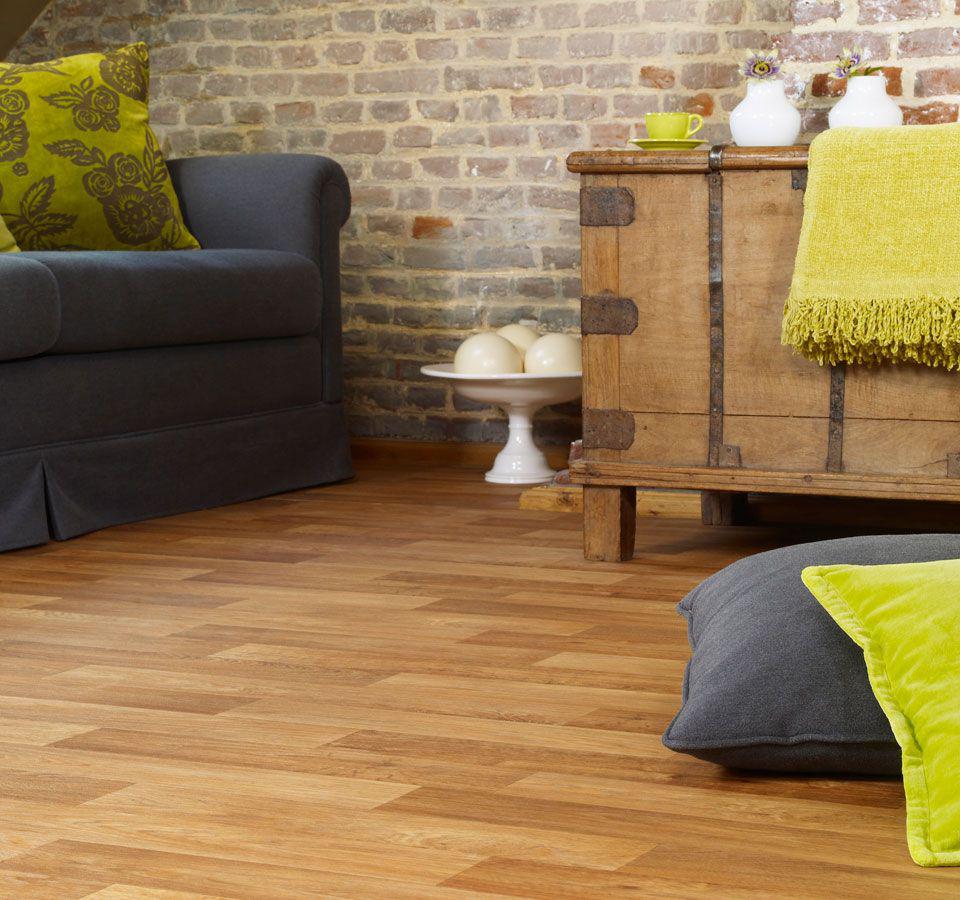
Price policy
Today, stores offer a huge range of linoleum, which is different in its characteristics, as well as the width of the roll. Depending on these indicators, the cost varies different types of and the sizes of linoleum.
The most expensive option - natural linoleum. Synthetic coating is much lower. If you compare low-cost versions of linoleum and laminate, the latter will be 1,5-2 times more expensive than linoleum.
Expensive options for linoleum and laminate, respectively, are much higher. For example, the price of laminate class 33 is about 1200 rubles per square meter, and a heterogeneous linoleum of excellent quality can be bought for only 450 rubles per square meter. m. But a good laminate 32 class can be purchased at a price of 300-400 rubles per square. m. In general, laminate, of course, more expensive, but we can not say that the price difference is very high.

Expert opinion
Any building product has its supporters and opponents. According to the designer Nadezhda Agafonova, linoleum "wins a little from the laminate in terms of external aesthetics." This material can simulate any pattern: wood, tile, parquet, etc. "An additional advantage can be considered approximately the same price category of both coatings", - the designer considers.
Master-trimmer Sergei Volkov to the main disadvantages of laminate refers to his "creak". According to him, one mistake in the laying of the material itself or the substrate is enough to make the coating "singing".
The builder, ex-construction supervisor DSC Alexander Gladyshev, on the contrary, stressed the minuses of linoleum. He noted the fact that this material quickly fades and tears, if laid on an uneven surface. "A fragment of laminate coating can be removed and fixed or replaced, but with linoleum such an operation is impossible. We will have to change the whole cover, "the master says.
Experts also stressed the high moisture resistance of linoleum and ease of maintenance. They agreed that both materials are somewhat inferior to each other, but on the whole they recognized the difference between their properties, characteristics and the price of insignificant.
Conclusion
So, what is better: laminate or linoleum? Comparison of both materials revealed the following facts:
- Both materials have a very wide color and pattern range.
- Laminate is more environmentally friendly, as it contains more natural substances. Nevertheless, both contain synthetic components.
- laminate and linoleum is due to the type, class of material.
- At a price, linoleum wins a little, but the price of both of these materials varies depending on the variety and quality.
- Laminate is afraid of water, damage, while linoleum can be washed many times. A small amount of water does not harm the PVC coating.
- Both materials have good sound and heat insulation properties. Linoleum, however, a little warmer. But both are suitable for underfloor heating.
As you can see, the difference is not that big. When choosing, be guided by your taste, as well as the technical characteristics and properties of certain types of both, and other material.
When carrying out repairs, the question often arises: what is better - a laminate or linoleum in an apartment? There is no unambiguous answer, since each of the materials has several categories that differ substantially in their main operational characteristics. In addition, the choice is largely determined by the characteristics of the premises - attendance, humidity, need for sanitation, the likelihood of mechanical damage, etc. There is also one more nuance - some properties of floor coverings depend on stacking - the quality of its performance, the use of a substrate, etc.
Laminate is sometimes called a natural material because of the presence of cellulose (wood) fibers in its composition; however, this is not entirely true, because the resin component serves as a binding component for them. In fact, the laminate base is pressed orgalite (more precisely - MDF or HDF), but in general the material is multilayered - the base is covered with protective layers on both sides. On the back side, the polymeric layer or kraft paper with phenolic impregnation protects mainly from moisture, and the outer (front) surface has a multifunctional coating made of acrylic or melamine resin, which partly prevents moisture (it is allowed to wipe the laminate with a wrung-out wet cloth, but with a direct hit water coating spoils) and protects against mechanical damage.
The question that it is better to lay: laminate or linoleum, is solved for a specific room, for example, for a kitchen with high humidity, laminate will not be the best solution.
The thickness of the surface protective layer determines the class of strength of the material, but even in the most stable coatings it does not exceed 1 mm.
Laminate flooring is a block floor covering (unlike a roll linoleum), which is mounted from small "boards".
- The most common laminate, in which the ends of all elements are click clips. The laying of such a coating is simplified as much as possible, although some call the lack of a click laminate the presence of small gaps between blocks in which moisture can enter. The obvious advantages of a laminate of this type include the possibility of creating a "floating" coating that does not have a rigid adhesion to the base floor on the entire surface.
- Less common are glue laminates, their laying is more difficult, because of the rigid connection to the floor surface, cracks may arise from thermal deformation if the room temperature changes abruptly, but the gaps between the lamia boards are impermeable to moisture if properly laid.
- The most common sheet pile laminate with a characteristic relief of the end faces.
 Types of laminate bonding
Types of laminate bonding The main disadvantage of the laminate is its susceptibility to moisture. Coverings of this type of any class do not carry water, are jarred, deformed and can not be restored. If moisture falls, you can replace the damaged elements, and the clipping cover will be enough to disassemble the damaged area, and "planted" on the glue boards will have to be cut.
Classes of laminate
The class of the floor covering and its purpose is determined by the strength of the material and the thickness of the upper protective layer.

Appearance
Initially, the laminate was used as a floor covering visually virtually indistinguishable from natural wood. Such models to date are popular, as attractive externally and organically combined with various interior styles. The assortment of the most famous manufacturers usually includes classic and original variations of the laminate for wood:
- natural (a thin layer of varnish is practically not noticeable and the coating looks like ordinary wood),
- glossy (in such models, the varnish coating is not only noticeable, but also a characteristic feature, the coating imitates the lacquered wood),
- matt (visually similar to a well-pro-polished natural parquet),
- aged (the color of this coating is darker than that of a tree "with experience"),
- textural (similar to boards with rough processing),
- waxed (warm and soft shine boards, characteristic for wooden floors, waxed).
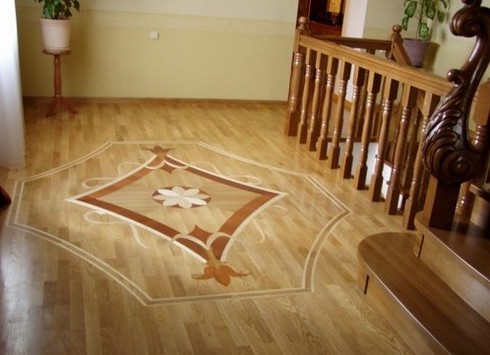
The technology of laminate production makes it possible to create coatings that are completely unlike wood, the most original and fashionable are laminates under the stone and under the skin.
Linoleum
Linoleum - roll flooring, the main advantages of which are moisture resistance and water resistance. Such material not only easily tolerates wet cleaning, including using detergents, but also (provided correct stacking) is able to delay the spilled or leaky water in small quantities. When choosing which is better - laminate or linoleum, the expert's opinion will be based on a combination of operational features and characteristics of different types of materials.
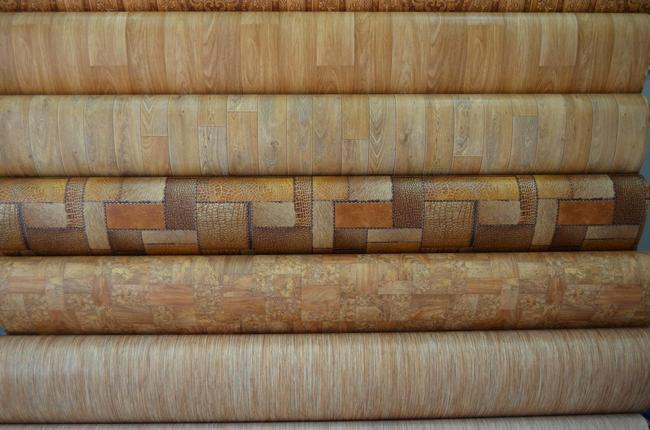
Materials for manufacturing
In many ways, the quality and characteristics of linoleum are determined by its type.
- Natural linoleum is so different from other species in composition, characteristics and price, which is increasingly isolated in a separate category of flooring and called marmoleum. On a jute-based basis, the marmoleum is coated only from natural ingredients - chalk and wood flour, bound by oxidized linseed oil and resins, and the drawing is done with natural dyes. Because of the high price, marmoleum should be excluded from the comparative analysis, whose purpose is to determine what is better, linoleum or laminate in the house.
- Nitrocellulose coatings differ in ductility and high strength at low thickness. Nevertheless, nitrocellulose linoleum is not recommended for use because of high flammability.
- Linoleum made of glyptal (special kind of plastic) is produced on a fabric basis and therefore is distinguished by increased heat and sound insulation. In the process of operation it is deformed - stretched out across the width and "shrinks" along the length.
- Linoleum made of rubber is the most waterproof and elastic, due to which it can easily be laid on an uneven base. At home, it is not used because it has a high toxicity.
- PVC linoleum is the most common type used for commercial premises, rooms in apartments and houses, therefore in the future the properties and purpose of this type of floor covering will be considered. Linoleum made of polyvinyl chloride may eventually "sit down" a bit. Such material is produced baseless or on a fabric, foamed, hairline basis.
PVC-linoleum production technology
According to the manufacturing method, PVC-linoleum can be homo- or heterogeneous.
- The choice of colors for heterogeneous linoleum is significantly greater because the coating pattern is exclusively in the upper layer of the laminate. This production technology removes almost all restrictions on the choice of gamma and the complexity of the drawing. Fiberglass in a heterogeneous linoleum prevents deformation of the stretching and compression of the floor covering.
- A homogeneous linoleum pattern is made for the entire thickness of the coating, so that it becomes resistant to abrasion. Unlike heterogeneous, homogeneous linoleum can be restored with a noticeable wear of the surface - such coatings "grind", removing 1 / 20-1 / 5 of the coating thickness with a homogeneous structure. The advantage of homogeneous varieties is high strength and durability. Such linoleum not only withstands the steps of people, but also retains its quality when moving carts and trolleys along it. At the same time, the coating service life is 25 years or more.
When deciding what is best to choose, laminate or linoleum in the apartment, it should be remembered that roll material looks a bit simpler and can not reliably imitate a tree, even if it has the corresponding drawing.
Classification of linoleum according to purpose
Linoleum different classes differs in strength and durability, however, each category has other nuances.
- The cheapest linoleum is household. It is most often a multi-layer material made of foamed PVC, a decorative layer and a protective coating. In sum, the thickness of all layers usually does not exceed 4 mm. The coating has a soft base and does not last very long even with a sparing operation.
- Semi-commercial type of coating can be called an improved version of household linoleum. It is more durable and has a greater thickness - from 0.7 cm. The structure of such coatings practically does not differ from the domestic roll material.
- Commercial linoleum is designed for significant loads and is characterized by maximum wear resistance. Due to the fact that this type of linoleum is often used for rooms with high attendance, the surface can have an additional anti-slip coating.
- Specialized, manufactured taking into account special requirements determined by the nuances of exploitation:
- sports with polyurethane coating,
- for medical institutions with bactericidal components in the surface layer,
- with reinforced sound insulation for music studios, rest rooms, etc.,
- with a relief on the surface, preventing glide, even when water hits the linoleum. 
Comparison of materials by main parameters
What is better to lay on the floor - a laminate or linoleum, decide in accordance with the requirements for a particular room. The choice will help to compare floor coverings for the most significant parameters.
Insulation properties
Heat and sound insulation properties of coatings of both types are determined in most cases by the characteristics of the substrate. What is warmer - laminate or linoleum - depends largely on its material and thickness. It is important to remember that for linoleum the substrate is a supplement, the use of which depends on the desire of the owner of the room, and for laminate it is an obligatory element when laying the coating. Among the various varieties of linoleum, the warmest are those that have a dense tissue or felt base.

Linoleum, due to its plasticity, absorbs sounds better, especially for a material with a soft base, while walking on a laminate in shoes with a hard sole or on the heels can be heard throughout the apartment. But here again to the aid of the laminate comes a quality substrate that serves as an excellent soundproofing device. 
Ecological compatibility
What is more ecological - laminate or linoleum? Both coatings (taking into account the fact that PVC material is chosen from a wide variety of linoleum variants) do not emit toxic substances during operation. When comparing the ecology, the complexity of utilizing linoleum is often mentioned, which burns with the formation of a sharp odor and the release of harmful substances. However, taking into account that it is extremely rare to use the removed cover for the owners of houses and apartments, this shortcoming can be considered not the most significant.
Transportation
Transportation of packed in compact blocks of laminate boards is much easier - they can be transported in a personal car and lifted to the floor in an elevator. Rolls of linoleum are large (the width of the roll can reach 5 m) and weigh a lot, so for their delivery to the site may require freight transport, and in a regular passenger elevator, such a roll may not fit.
Stacking and repair
Laying linoleum and laminate is quite simple and to get a high quality coating for a home master it's enough to follow the instructions, but still assembling a laminate floor requires a more responsible approach. Covering of the roll material requires less time compared to the assembly of the planking, although this will require the use of adhesive or double-sided adhesive tape. 
At the same time, for the device of flooring from a laminate the floor should be as much as possible equal, in this connection it can be required preliminary its alignment by means of special building mixes.
Laminate is more repairable material, if necessary, such a floor can be partially dismantled and some of the boards replaced with new ones. Also, small chips and cracks on the panels are perfectly sealed with the help of special repair pastes. The Lenoleum can not be repaired in this way and it will have to be changed entirely, and it is more inclined to get scratches and other similar damages.
Moisture resistance
One of the most significant differences in coatings is that the laminate does not tolerate moisture, and linoleum does not change its qualities even when a large amount of water is ingested. Although it should be noted that there are moisture resistant laminate models.
Appearance and features of operation
Despite the new technologies, the roll material does not look so presentable and can not reliably imitate a natural tree, although imitation of other materials by linoleum is very good.
Speaking about the features of use, it should be noted that heavy furniture and heels can leave marks on the linoleum, whereas laminate is more durable in this respect and material.
Caring for the laminate should prevent washing the floor with a damp cloth (you can use a well-wrung out wet cloth or mop), while for linoleum care there are no such restrictions.
Taking into account all the advantages and disadvantages, it is most often recommended to choose linoleum in the home for rooms where water can get on the cover, besides, excessive humidity can be present in the air - bathrooms, kitchens, balconies. The hallway is often washed. Therefore, it is also good to choose linoleum. Laying linoleum in the pantry is justified by the economy and ease of installation of the coating.
In children's rooms, dining rooms, living rooms, bedrooms, the laminate will look great and retain its durability.
And finally, speaking about the cost, we note that when choosing between the laminate and linoleum of the middle price category, the price wins linoleum and the difference in price can differ by half.
The opinions of experts on laminate and linoleum can also be found in the video.
Tweet
Plush
Intending to perestilat floor in the apartment, the homeowners are thinking about - and which, in fact, cover the bed on the floor. Of course, a massive board or natural parquet is a luxurious and presentable option, however, not everyone has a decent amount in their pocket.
Therefore, most often people choose budgetary options - laminate or linoleum. There are arguments in favor of the laminate, but linoleum has many advantages. In this article, we will examine the features of each of these materials and find out which of them better suited for an apartment.
Laminate can often be found on sale with the marking - "natural coating". This is due to the fact that the laminate contains fibers of natural cellulose, however, this material is, of course, not completely natural. Binds the fibers together with a real synthetic resin. It turns out a hybrid of natural and chemical material.
pros
Laminate - a multi-layer material, based on its usual MDF or HDF. Its great advantage is that on one side (external) a clear polymeric resin is applied to the coating, which protects the woody vulnerable layers of the material from penetration of moisture. But a large amount of water coating will not survive.
On the photo-laminate for the apartmentIf you buy a laminate of increased strength (it is marked with the numerals 34), then this material has great strength and is capable of withstanding significant loads. The price of it, of course, will be quite expensive, but such a laminate can last at least 30 years without losing its external decorative qualities and performance properties.
This coating is very aesthetic. It looks like a natural tree or a massive board, gives the room a noble appearance, fits perfectly into any design.
A variety of choice of laminate allows you to choose the material for almost any design. This floor covering can be of different colors, patterns, can imitate any kind of wood, even stone and skin.
On the video - which is cheaper for an apartment: laminate or linoleum:
Minuses
Laminate can not be washed with a lot of water, it is highly recommended not to spill liquid. From getting water, the laminate can swell and deform. He only tolerates light cleaning with a damp cloth. Because of the intolerance of moisture, laminate will be impractical to use in those apartment rooms where the probability of humidity is increased - kitchen, bathroom, hallway. Water can so destroy the coating that the slats completely deform, lose their appearance, and will be unsuitable for use.
Whether it is necessary to lay linoleum
Rubber linoleum is highly elastic, so it is easy to fit and operate, but due to high toxicity is not suitable for household use. In the apartments we use PVC linoleum, abbreviated - PVC.
pros
This flooring is characterized by a cheaper cost than laminate flooring - this factor can sometimes be important.
The waterproofness of linoleum makes it an indispensable coating for kitchens, hallways and bathrooms. Linoleum is very practical, not afraid of spilled liquids, frequent wet cleanings, does not lose its external and technical characteristics. Linoleum is able even for a while to restrain the pressure of water in emergency situations.
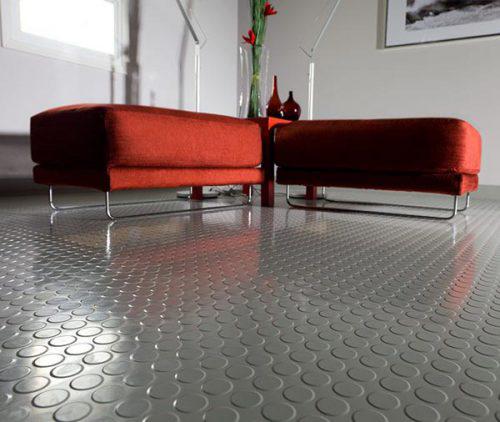 On the photo- rubber linoleum
On the photo- rubber linoleum Among all the variety of types of linoleum, you can even find natural, so-called, marmolinoleum. This kind of material has a jute base, and the pattern on it is carried out with the help of natural dyes. It is worth bearing in mind this option, if you want a natural material that has practical characteristics of linoleum.
The material has several of its varieties, which differ significantly in their operational and aesthetic characteristics.
So, household linoleum has low wear resistance and not too high decorative qualities, but this is the cheapest floor covering.
But the commercial option, although it is much more expensive, however, has such high technical and aesthetic characteristics that it can serve without problems for several decades.
Which is worth using, is detailed in the photo in this article.
But what kind of substrate under the linoleum on the wooden floor is to choose and use, is described in this
And here what responses about a cork substrate under linoleum exist, it is possible to learn or find out
Minuses
The main disadvantage of PVC-linoleum, which is used for apartments, are its low aesthetic properties. Few decide to lay linoleum in the living rooms - it is much "cheaper" general form room. This is one of the most serious shortcomings in coverage.
Due to the fact that linoleum is a completely synthetic material on an adhesive basis, the coating has a solid texture, practically does not allow air to pass through, hence - the room does not "breathe", ventilation and air circulation are disturbed. It is for this reason that linoleum is recommended only for those rooms where people are not constantly. These are rooms with a purely practical purpose - bathroom, kitchen, hallway.
On the video - what is better in the kitchen: laminate or linoleum:
Linoleum with time can "sit down", that is, after a few years you can be surprised to notice that the cover no longer reaches the walls, but departs from them. In these intervals, dirt can be clogged, as a result, the overall aesthetics and the appearance of the room are lost.
Comparison of materials
Insulating properties
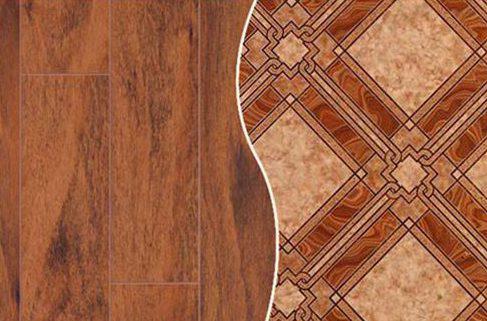
When choosing a floor covering in our cool latitudes, an important nuance is how much a particular material is able to protect the apartment from the cold in the winter. This property in both linoleum and laminate depends on how thick the material is. If you want to choose a warm linoleum, then pay attention to its variety with a felt base or fabric. A laminate is the warmest one that has a thickened substrate.
It should be noted that linoleum due to its soft texture has excellent sound-absorbing characteristics - it can literally walk silently. But laminate flooring does not have noise-absorbing properties - loud footsteps will be heard throughout the apartment. However, if the laminate has a high-quality and thick substrate, then this problem is easily solved.
Ecological compatibility
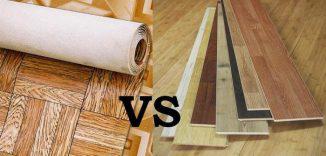
It should be noted that both these materials do not emit toxic substances. This alone makes them completely eco-friendly floor coverings. However, linoleum can cause harmful vapors during combustion, which makes it difficult to dispose of.
Of course, the owners themselves rarely deal with recycling floor covering, so this factor can be considered insignificant. But the roll material does not pass air very well, making it difficult to circulate in the room. Therefore, for the environmentally friendly laminate flooring.
Transportation
With regard to transportation, laminate is much more convenient than linoleum - its small bars can be compactly packed, unlike bulk rolls of linoleum. Sometimes linoleum is so wide that it is difficult even to transport it in an elevator - it is necessary to lift it to the right floor on its own.
Installation
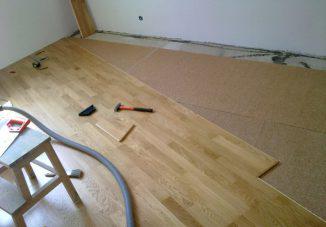
In this respect, both materials are quite simple, however, laying the laminate requires more knowledge and skills than linoleum flooring. For linoleum, sometimes only a pair of hands, a special glue and a good eye is enough - and the coating will be laid exactly.
And laminate has to be assembled and customized like puzzles, so you have to try a little more. On the other hand, in order to lay linoleum, you will need to level the floor, and for laminate it is not necessary.
If necessary, several damaged laminate laths can be replaced with new ones - with linoleum such a number will not work - if the material is spoiled, it will be necessary to completely rearrange all the covering in the room.
Linoleum - softer material, therefore, less wear-resistant - it easily stains and scratches, it is afraid of mechanical damage.
Moisture resistance
In this respect, linoleum is much ahead of the laminate, since water for it is not a problem. Where laminate flooring is deformed and deformed, linoleum will stand firm, without losing its appearance and technical properties.
Appearance
Roll materials on external presentability lose solid floor coverings. Therefore, the aesthetic characteristics of the laminate wins. Although linoleum is capable of masterfully imitating various types of wood, colors, patterns, textures and shades, it is immediately evident that this is an imitation, and not a real, say, oak floor.
Flooring of different rooms
We'll figure out what to prefer as a floor covering for different rooms in home.
Living room
In this central room apartment, of course, it will be better to look laminate, as a more presentable floor covering. Modest and practical linoleum here is not too "fit".
 On the photo-laminate in the living room
On the photo-laminate in the living room The living room should make an impression - guests are gathered here and meetings are held, that's why this room should show the material prosperity and taste of the owners. Laminate better meets this condition.
Bedroom
For this premise it is also better to choose a laminate, because the bedroom does not have much practical value - there will not be a lot of dirt, moisture, you do not need to clean it up constantly. Laminate better emphasize the beauty and relaxation of the bedroom, especially if the material is chosen a light shade.
 On the photo-laminate to the bedroom
On the photo-laminate to the bedroom Kitchen
 On the photo-linoleum in the kitchen
On the photo-linoleum in the kitchen Since the kitchen is the place where stains, sprays and other sources of pollution are unavoidable, a floor covering is needed to keep the room in order. And here's what parameters you should pay attention to, will help to understand the information from the article.
Bathroom
As for this room, the best is linoleum, because the bathroom does not exclude water leaks, permanent splashes in hygiene procedures. Laminate can not withstand the high humidity of this room.
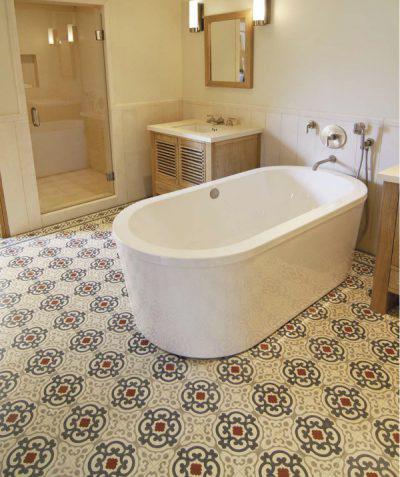 On the photo-linoleum in the bathroom
On the photo-linoleum in the bathroom Entrance hall
For the hallway, linoleum is best suited, as street dampness and dirt first come here. It is more practical to protect the floor from leaks with the help of a material that is easy and easy to maintain. But how to glue linoleum to the floor and what is the price of glue for linoleum on the wooden floor, you can learn from this
 On the photo-linoleum in the hallway
On the photo-linoleum in the hallway But whether you can use it and how it can be done correctly, you can understand the information from the article.
What characteristics of Tarkett's semi-commercial linoleum exist, you can find out if you read this
Summarizing
We examined the main characteristics of laminate and linoleum. As you can see, both materials have their pros and cons. And each of them is suitable for individual rooms in the house. therefore the best choice will be the use for different rooms of their material. But the linoleum and laminate in this case must be selected in such a way that they are as similar as possible to the pattern and color - this will create the appearance of a single coating.
Planning repairs in their apartments, many are faced with the choice of flooring. Building supermarkets offer us a wide choice of floor coverings - from expensive natural wood, parquet, natural stone, to cheaper options, such as ceramic tile, laminate, as well as artificial coatings - linoleum, carpet, vinyl floor.
The most popular at the moment are laminate and linoleum. what better linoleum or laminate in an apartment? What are the advantages and disadvantages of each of these solutions? Before making the choice that it is better to lay a laminate or linoleum in your apartment, it is worthwhile to understand the characteristics of these finishing materials.
What is linoleum?
Linoleum was invented by the Englishman Frederick Walton, who patented it in 1860 (linum - flax, olenum - oil). In 1869, he founded a linoleum production plant in England, and began to export it to Europe and the United States. Previously, this type of flooring was very often used, because it is cheap and relatively aesthetic. Unfortunately, the materials of the older generation were not very stable and short-lived. Therefore, if you buy an apartment with an old linoleum, as a rule, it is a miserable sight. Floors made of soft PVC and other similar materials, which belong to outdated versions of linoleum, are not suitable for repair, and should be removed.
Currently, linoleum is of high quality and it is sometimes difficult to distinguish such a coating from those materials that it imitates, for example, from tiles. At the same time, the floors are warm and soft, which is especially appreciated in the kitchen, when the fallen plates do not break. Let's also note that linoleum can be laid on curves, unprepared surfaces, on which it would be impossible to glue the tiles without sufficiently serious preparation.
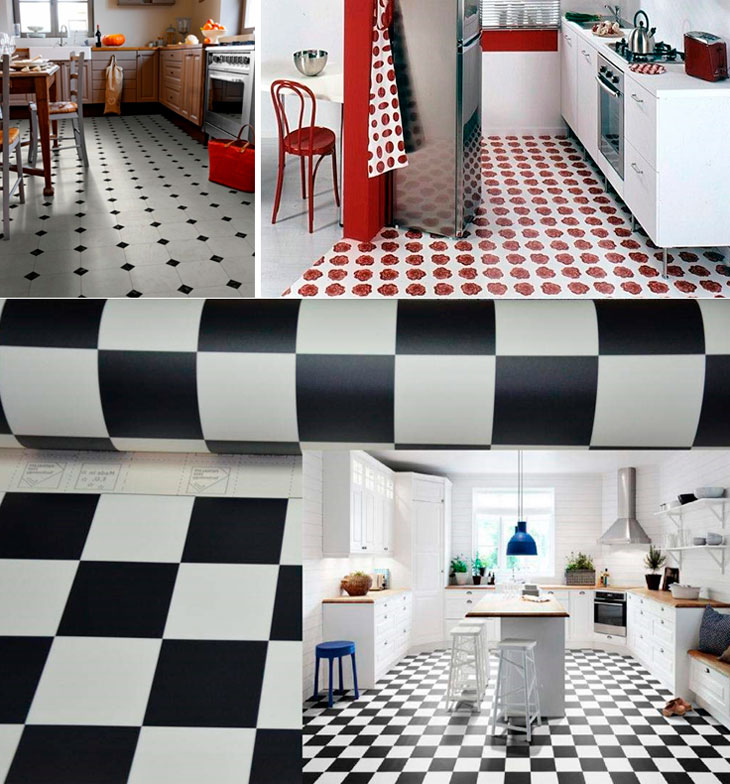
All floors have their own optical orientation, that is, they look better or worse, depending on the direction of the light. On the floor, we usually look, looking in the direction of the window, and not vice versa. Therefore, you should carefully choose the pattern and place it in the right direction.
Advantages of linoleum
Linoleum has a number of significant advantages:
- it does not deform and does not swell under the action of moisture, as it can be when using a non-moisture resistant low-grade laminate;
- thanks to its strength it is easy to clean, you can wash it with water and do not worry about excess moisture;
- when it is installed, there is not as many stitches as in the case of a laminate in which dust and moisture can accumulate;
- coverage of this type can also be used in the bathroom and other places exposed to moisture and dirt places - for example, in the hallway, in the kitchen;
- it is also important that in terms of economy it is better to put linoleum, laminate is much more expensive;
- it can easily be replaced, it does not require large financial and labor costs, if there is a desire to change the interior design;
- a rich palette of colors, patterns and imitations will successfully adapt it to furniture or accessories, laminate can not boast such a variety;
- it can provide a uniform color surface;
- we can do the installation ourselves; for this, we do not necessarily need a master;
- styling does not take much time;
- most modern products have antistatic properties.
Linoleum also differs in thickness - thicker versions are suitable for uneven surfaces, they are durable, but also cost more. You should also consider choosing non-slip linoleum, which will improve the safety and comfort of family members.
Disadvantages of linoleum
- it can be deformed if you install heavy furniture and household appliances on it;
- it does not look as elegant as a laminate, and with improper installation, dust and dirt can accumulate beneath it;
- as a rule, has poor sound insulation;
- thermal insulation is not very good, especially in thin versions;
- cheap models can quickly wear out, undergo fading and deformation.
Laminate and its properties
Laminate has been used for many years and is becoming more popular. He captivates us with a wide choice of designs and colors, which makes it possible to create a beautiful, perfect interior.
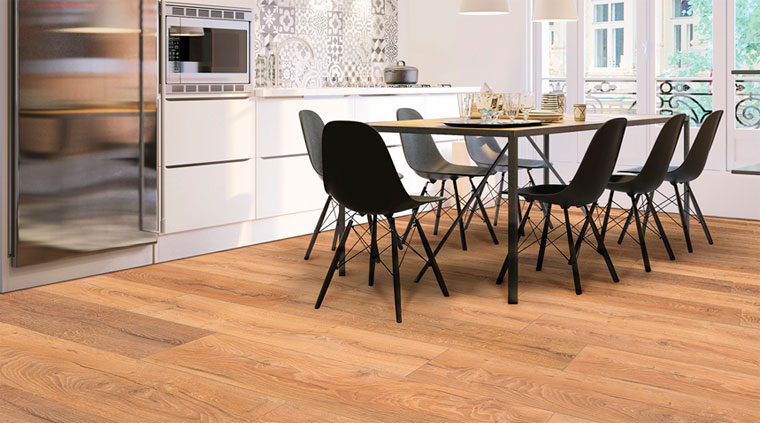
Nevertheless, many people choose such a floor, being guided, first of all, by practicality - modern laminate, despite a very reasonable price, has excellent performance characteristics. Classification of the laminate allows you to choose an option that suits the properties for different rooms - with high humidity, with weak or intensive movement. This type of floor covering is used wherever aesthetic properties of wooden surfaces are required, but the conditions do not allow the use of parquet.
Laminate, as well as all other materials for public buildings must have appropriate certificates, confirming its quality and safety. Due to the fact that it is made using synthetic resin, the coating is characterized by a lower price compared to wood and parquet, it is much more resistant to dents and scratches on the surface.

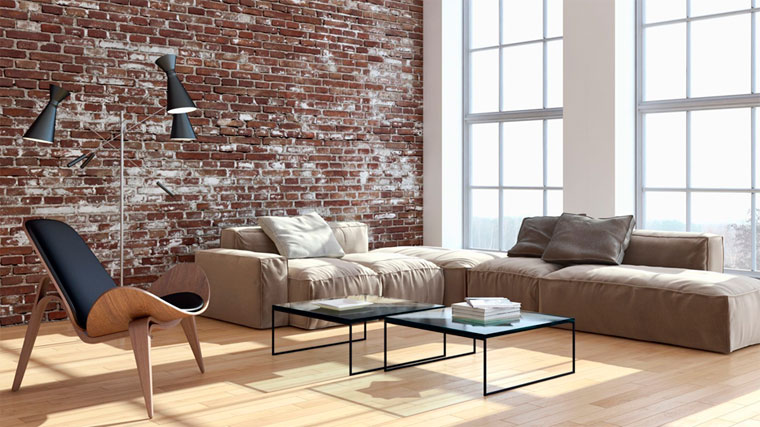
Advantages of laminate
- he looks very elegant;
- creates the impression of comfort;
- suitable for most interior styles;
- not all, but many models have antistatic properties, the surface does not settle a lot of dust (always check the label on the package);
- has a fairly large selection of patterns and textures, although not as much as in the case of PVC coatings;
- its surface is fairly easy to keep clean;
- panels that are connected without glue can be removed quite easily, in addition, if necessary, they can be moved and placed elsewhere;
- many models are suitable for installation on heated floors.
Lacks of laminate
- as a rule, it has a low resistance to moisture, therefore, deciding that it is better in the kitchen for laminate or linoleum, it is better to choose a linoleum or a laminate of a higher class of moisture resistance, which will be quite expensive;
- some panels can sometimes be slippery, for example, if they get wet, which can be dangerous for family members, and will not be very convenient for pets, increasing the risk of falling and injury;
- not very good sound insulation, inferior in this quality linoleum.
Which is better: laminate or linoleum for allergy sufferers?
Allergy is a disease that can complicate the conditions of life. Among the most frequently mentioned allergens, dust mites are the most common. During everyday life, house dust with mites rises with air and can cause allergic reactions. You can, however, reduce the amount of floating dust by choosing the right type of flooring.
- Laminate. Acquiring laminate flooring should only choose one that has the appropriate composition. It is necessary to pay attention to the varnish that can cover the surface of panels and the presence of formaldehyde - a substance that includes the glue used to bind wood fibers inside the panels. Increasingly available in the market are laminated panels that do not cause allergic conditions, thanks to a special chemically inert and safe surface layer for health. The use of such coatings eliminates the risk of floating volatile substances. Most types of laminate have a strong surface, which is resistant to water and mechanical damage. Thus, it can be taken care of daily, vacuumed and washed, reducing the amount of dust in the apartment.
- Linoleum. This material is a little out of fashion, but, apparently, again begins to enjoy attention. And it's good, because flexible coatings, such as linoleum, are ideal for people with allergies. This type of floor perfectly tolerates daily wet cleaning. The surface can be washed with water, without fear that moisture will cause harm to the floor. PVC floor coverings should have antistatic properties and do not attract dust, which will be an added advantage for people with allergies. When buying, however, products made of pressed vegetable fibers, which can be a source of mold, should be avoided. It is not necessary to save and buy cheap linoleum from little-known manufacturers, since it can contain substances harmful to health. Before buying it is necessary to check the quality certificates and find out for which rooms this product is intended.
Laminate or linoleum, which is better - opinions and reviews
Laying the laminate will cost more than laying linoleum and will last longer, but such a floor will serve us for many years, without losing its qualities.
Linoleum is an incredibly plastic material, it has been covered by a floor for a century and a half already. It has its pros and cons, however, it is still successfully used in kitchens and corridors, where the floor is very vulnerable to deformation. Compared with laminate, linoleum is better in terms of the possibility of achieving non-standard visual effects, it has different patterns and colors that can be selected for any type of interior. The material has a wide range of patterns, imitating parquet, boards, contains modern colorful geometric shapes, imitates on the floor fine pebbles and sand.

What is better to lay a laminate or linoleum? If the floor is flat, then the cheapest option is linoleum. It is much cheaper than a laminate or a wooden floor, so if you do not have extra money, you can use this type of flooring. Linoleum is extremely plastic material, so cutting and other types of work associated with its laying are simple. If a small deformation appears on it, then after a while it disappears by itself.
But, we must take into account that the interior with linoleum will not look as beautiful as with a laminate, however, using it, you can create a beautiful, impressive and memorable solution by connecting the imagination.
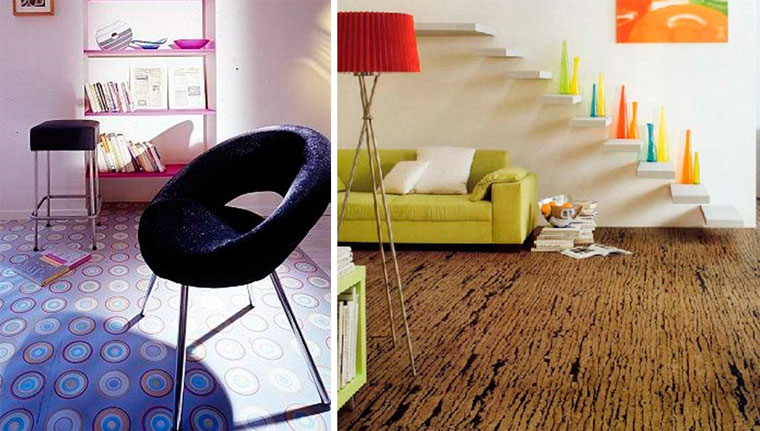
And what is better in the room: laminate or linoleum? For the living room and bedroom is better, after all laminate. There is no excess moisture, so it is not necessary to choose the most expensive class, but it will still look more elegant and aesthetic.
Nevertheless, in each concrete case the decision that it is better to choose - linoleum or laminate for the whole apartment or individual rooms, can be different, as it depends on the condition of the floor, the budget for buying and installing the floor covering, the features of exploitation, the habits of the household and other factors. If you have an opinion about a laminate or linoleum, which is better, feedback on the exploitation of these materials can be left in the comments to the article.

